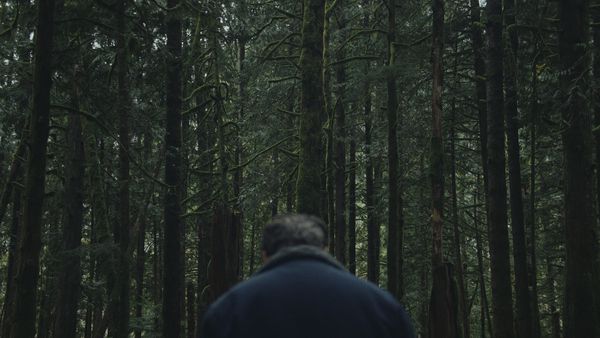‘To Kill a Wolf’, directed by James Remington, is a haunting exploration of human frailty, resilience, and unexpected companionship set against the brooding landscape of the Oregon wilderness. This introspective drama follows two fractured souls—a reclusive woodsman (Ivan Martin) and a teenage runaway, Dani (Maddison Brown)— brought together by fate and necessity. It’s a story wrapped in the textures of mist and melancholy, with close-quarter cinematography that pulls viewers into the raw intimacy of a journey that’s as much about confronting inner demons as it is about survival.
The film begins with the woodsman discovering Dani, nearly frozen in the wilderness, lying lifelessly among the trees. With frost clinging to her clothes and life ebbing away, she’s like a ghost who’s already succumbed to the forest. Martin’s woodsman, stoic and reserved, takes her to his cabin, reviving her with warmth and sustenance. Dani’s reasons for being in the wilderness are murky, but it’s clear that whatever drove her there wasn’t mere wanderlust. The woodsman is reluctant to get involved, but he agrees to help her reach her grandmother’s house—a decision that sets them on a reluctant path of companionship and self-discovery.
The film’s title symbolizes the characters’ internal battles; “wolves” lurking within Dani and the woodsman—traumas, regrets, and painful memories they’ve been avoiding. In Oregon’s forests, real wolves are rare and carefully managed, posing little threat to humans. The true dangers lie within the hearts and minds of those who seek refuge in the woods. Dani and the woodsman, each carrying heavy secrets, mirror these wolves’ quiet, haunting presence, hiding wounds and fears that are ultimately harder to face than any wild creature.
‘To Kill a Wolf’ excels in visual storytelling thanks to cinematographer Adam Lee’s masterful approach. Lee’s shots capture the Oregon wilderness and the raw texture of the characters’ isolation. The camera lingers on the peeling bark, mist, and dilapidated interiors, creating an atmosphere heavy with foreboding. The characters’ surroundings echo their inner desolation; stripped-down visuals amplify their loneliness and vulnerability. This aesthetic, grounded in shades of grey and damp earth tones, feels like the woods themselves are swallowing them, reflecting the oppressive weight of their unresolved pasts.
Martin and Brown deliver performances that are as haunting as they are heartfelt. Martin’s woodsman is a portrait of quiet suffering, his eyes betraying a wounded soul beneath a hardened exterior. Brown’s Dani is fierce yet fragile, her youthful bravado masking a more profound vulnerability. Together, they embody two lost souls with little to offer but their presence, yet somehow manage to reach out to each other. Their exchanges are sparse but loaded with tension and unspoken fears, each interaction peeling back another layer of their guarded personalities.
There’s an undeniable fairy-tale element in ‘To Kill a Wolf’—a nod to Red Riding Hood, with Dani venturing into the woods to confront an unknown danger. Yet Remington subverts traditional fairy-tale resolutions. The film is careful not to offer clear-cut answers or redemptive endings, suggesting that healing is possible only when people are willing to confront their pain.
With restrained yet deeply impactful storytelling, ‘To Kill a Wolf’ is a testament to the beauty of connection forged through adversity. No grand transformations occur in the film’s final moments, but a glimmer of hope emerges. This isn’t a story about conquering wilderness or defeating personal demons but about the small, crucial steps toward redemption. The result is a deeply resonant film that lingers long after the final frame—a dark, tender tale of two broken people finding solace, however briefly, in each other’s company.
